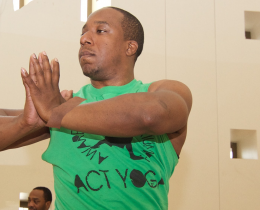Omega: You are a former neurofeedback researcher with a degree in English and philosophy. How did you first find yoga?
Beryl: I moved to Los Angeles from New York in 1970 because I wanted to move "to the country," and as I recall, there was a "boy" involved. I was also trying to be an actor, very unsuccessfully! I did do a bunch of TV commercials and worked as an extra in a lot of films that were shot in New York City in the 1960s. It was just enough to keep me thinking that it might be a good path for me. So off I went to California.
I needed a job to sustain me, while I waited to be "discovered," and had a friend who was working at the Biofeedback Research Institute of Los Angeles. At the time, the two directors were studying the brainwave patterns of meditators and hired me as an assistant. I became instantly fascinated by meditation and began to practice with the aid of neurofeedback.
California in the early 1970s was the epicenter of the human potential movement. There was so much going on. There were teachers coming from India. Swami Satchidananda was there, and Swami Vishnudevananda, Yogi Bhajan, and Chögyam Trungpa Rinpoche—all in California.
One day I was on my way to a lecture at UCLA by Baba Ram Dass. He had just written Be Here Now, and that was the hot book that year. I remember stumbling up these steps on the UCLA campus and as I sat down to collect myself, I saw this flyer advertising a yoga class. I thought, "Maybe I should try that." My very first asana was with Yogi Bhajan.
It was a 10-week course in Kundalini Yoga, and I don’t remember much except all his devotees were always cooking him dinner, and the class always smelled like Indian food. Around that time I met a radiant Jain monk by the name of Gurudev Shree Chitrabhanu. He was the first Jain monk to come to the United States, at the invitation of Harvard Divinity School, and was a brilliant, charismatic spiritual teacher.
He taught me meditation techniques from the ancient Jain tradition, as well as the two primary Jain principles—ahimsa (non-violence) and anekantavada (relativity of thinking, literally, “many-sided”—the two primary Jain principles). I also spent several years, while in California, studying Tibetan meditation with Chogyam Trungpa Rinpoche, the founder of Shambala, Sivananda Yoga with the Sivananda Yoga School, and Iyengar Yoga with many of the senior Iyengar teachers at that time, such as Judith Lasater, George Purvis, Aadil Palkhivala, Manousos Manos and others.
Omega: What do you think of all the science that now confirms that the practice of yoga has tangible health benefits, including improved brain function?
Beryl: I think it’s a byproduct of our time that in order to convince the general public and the medical and scientific communities that yoga actually works, we need to have clinical trials and evidence-based research and hard data. So researchers look at data done on people who actually practice, rather than practice themselves. Yoga is a very non-dogmatic, non-ideological system. It is totally empirically substantiated. You follow the methodology and it leads you to the experience and the benefits.
The only way yoga works is if you do it. And that’s the biggest challenge, period.
I was invited to teach at the Science of Consciousness conference in San Diego, which is sponsored by the University of Arizona. There were physicists, biologists, cosmologists, and astrophysicists from all over the world—the brightest of the bright. They were all looking at consciousness from the outside in.
I taught a meditation class every morning and did a little abstract presentation on the practice of meditation and how it leads to an awareness that everything is connected. Out of the hundreds of scientists that were at the conference, only three came to my meditation class in the mornings. I thought that was significant. My thesis was that the only way to study consciousness is from the inside out.
I think the reason so many people are interested in this research is because it’s required for funding. For anyone who wants to start a yoga program in a prison, for at-risk youth, or for people with addictions, the powers that be seem to require substantiation, evidence-based data. So to get funding to run these programs, we seem to require clinical trials and data. It is kind of contrary to the tradition of yoga. But “traditions” change. That’s hard for us. Everything changes. Nothing in the world of form is permanent. Nothing.
Omega: In the early 1980s you introduced Power Yoga, a dynamic flow of postures and breathing. What do you think of all the yoga trends today such as goat yoga and more?
Beryl: The name Power Yoga came to me in a meditation, and I thought it was brilliant because it was a great way, back in the 1980s, to let people know that yoga was a workout. It had been really soft in the 1970s. It was also a name that Western minds could relate to.
When my first book came out, I did a book signing at Barnes & Noble in New York City and I asked the couple hundred people there, "How many of you would be here if the name of this book were called Astanga Yoga? And they all looked at me like I had two heads. It was like, 'Huh?'"
Astanga Yoga was totally obscure then. I was and still am an Astanga practitioner. I teach a number of variations on that theme, from vinyasa flow to a sequence called Present Power, which is actually a combination of first and second series that can be modified for anyone from someone in a wheelchair to an Olympic athlete.
But because I wrote about Astanga Yoga and called it Power Yoga, and because I offered modifications, and because I did not choose to be a devotee of Pattabhi Jois, I got thrown out of the Astanga church.
I am still grateful to Jois. We wouldn’t be here talking if it weren’t for him. But I didn’t like the way he treated women, and I didn’t like the way he treated people often, in general. I was respectful and a very good student, but I didn’t feel inspired to kiss his feet, quite frankly.
Because it wasn’t trademarked, Power Yoga became anything anybody wanted it to be. I eventually became sort of embarrassed to be associated with it. I remember Yoga Journal wrote an article about me, calling me the queen of Power Yoga, and I was horrified because I'm not a queen, I’m a serious student of yoga philosophy and the yoga lifestyle, and to me, asana is just one very small part of the practice of yoga.
In terms of goat yoga and all this other stuff, I think it’s fine. Goats aren’t any more or less a distraction than music, babies, dogs, or any of the other stuff that people drag into yoga classes. I think whatever gets people in the door is good. Eventually, you get rid of all the peripheral entertainment that is required to keep you interested, and you learn to focus. You learn that yoga is about learning to pay attention.
It’s not about entertainment or listening to the Grateful Dead or Maroon 5. It’s about getting quiet and turning inward and calming the pond in the mind. Once the pond is calm, then you can begin to look deeply into that pond and have insights about what is going on in your life.



